Abstract
Life Cycle Impact Assessments (LCIAs) examine the environmental impacts of products using life cycle inventories (LCIs) of quantified inputs and outputs of a product through its life cycle. Currently, estimated impacts from mining are dominated by long-term metal release from tailings due to inaccurate assumptions regarding metal release and transport within and from mine materials. A conceptual model approach is proposed to support the development of a new database of LCI data, applying mechanistic processes required for the release and transport of metals through tailings and categorizing model inputs into ‘bins’. The binning approach argues for accuracy over precision, noting that precise metal release rates are likely impossible with the often-limited data available. Three case studies show the range of forecasted metal release rates, where even after decades of monitoring within the tailings and underlying aquifer, metal release rates span several orders of magnitude (<100 mg/L to >100,000 mg/L sulfate at the Faro Mine). The proposed tool may be useful for the development of a new database of LCI data, as well as to analyze mine’s regional considerations during designs for risk evaluation, management and control prior to development, when data is also scarce.
1. Introduction
Though mining is necessary to produce materials required for a low-carbon future, mine rock and tailings produced from the extraction process may pose risks to the receiving environment through metal leaching and acid rock drainage (ML/ARD). Sources of mine materials, during construction and mine life, occur on a mine site, including tailings storage facilities (TSFs), mine rock stockpiles (or waste rock piles), ore and low-grade ore stockpiles, heap leach pads, exposed pit walls, and underground workings. While global attention has been brought to tailings due to headlines about the environmental and social disasters associated with tailings dam failures, acidity measured from more than 40 sites over the last 25 years illustrates that around 60%–80% of the acidity generated at a mine site typically comes from the presence of mine rock stockpiles, with another 20%–30% attributed to TSFs [1] (which may at least partly come from mine rock used in the construction material of TSF dam embankments and starter dikes).
Life Cycle Assessments (LCAs) are used to evaluate environmental impacts of different products, processes, or services across their entire life cycle [2,3,4]. As part of completing the LCA, a life cycle inventory (LCI) compiles and quantifies the inputs and outputs of a product system through the product’s life cycle. The LCI is the component that accounts for the extraction of raw resources and equations to quantify total releases (e.g., of metals) per unit of function delivered by the product. Finally, the Life Cycle Impact Assessment (LCIA) is completed to quantify the environmental impacts using LCI data and impact (e.g., toxicity) modeling. Currently, ecoinvent (the most used source of LCI data in LCA) evaluates the release of metals from tailings using a landfill model developed by Gabor Doka [5,6,7]. Evaluation of metals released over the long-term by use of this model results in all metals present in a TSF being represented as released into groundwater and surface water. This method fails to capture the mechanistic processes responsible in the real world for variability of metals release from mine tailings facilities, which is controlled by site-specific parameters, such as geological conditions and climate [8]. Models that use site-specific values tend to yield lower impact results than those using generic data [9]. Assuming all metals will eventually be released into the environment neglects the significant unit processes used within the mining industry to manage waste and implement Closure strategies to mitigate the long-term release of metals and generation of ML/ARD (e.g., [10,11,12,13,14,15,16,17,18,19]). The timeframes evaluated in the Doka models (100 years and 60,000 years) do not evaluate risks of metal release during the Operations phase (on the order of decades) which is a significant focus of environmental evaluation in the industry presently, and results in estimates of metal release that substantially differ from the ML/ARD forecasted concentrations after Closure, through which placed cover systems or dewatering of tailings may change the release rates substantially. While reactive transport models have emerged in recent years as a more site-specific approach for TSFs [8,9], the development of a verified, site-specific reactive transport model often requires more data than would be available publicly and requires considerable time and effort to calibrate such models to produce meaningful results. Reactive transport modeling therefore appears impractical when applied on a global scale for producing data for LCIs.
To better address the release of metals from tailings, a new, conceptual model approach, using foundational elements of TSFs, together with a workable number of scenarios (combinations of climate, geologic conditions, hydrogeologic conditions, and process categories) presented in this paper is proposed to form the basis of a new database of LCI data to estimate releases from tailings facilities over different timeframes. The aim of this work is to introduce a tailings conceptual model approach that can be used to develop an LCI to evaluate metal release under more realistic timeframes (i.e., <50 years, and >100–200 years) and which captures mechanistic processes. The method presented here relies on a ‘binning’ approach that is used in the mining industry such as risk assessment using a Failure Modes and Effects Analysis (FMEA) [20,21] and by the International Network of Acid Prevention (INAP) Global Cover Guidance Document [19]. The methods utilized in FMEA and by INAP rely on categorization or fuzzy logic (or a combination of these), where verbal descriptions (e.g., ‘Low’, ‘Medium’, ‘High’, etc.) may be applied to represent a range of values [20]. The conceptual model approach proposed is tested on three TSF case studies, where sites were selected based on availability of data (i.e., public domain and extensively studied) as well as to ensure that a range of climate, geologic and hydrogeologic conditions were captured. These case studies are used to demonstrate a proof-of-concept for the conceptual model approach, which will require support from the industry for the archetypes used in the tool and to develop a new LCI following the conceptual model approach.
1.1. Conceptual Model Tool Approach
A conceptual model is a tool used to identify and outline key processes happening in a real-world system that the user is interested in quantifying. Building a conceptual model is therefore the first step in building numerical, mathematical, or reactive transport models [22,23], as it is necessary to understand processes important to a particular system before diving into the calculations. The conceptual model approach proposed here leverages this idea by outlining key inputs necessary to estimate metals release from TSFs. The user is guided through inputs phrased as questions to capture important features of TSFs, using a ‘binning’, or categorization approach to capture the variability in parameters important for metal release from tailings on a global scale. Model outcomes are informed by mechanistic processes used as a basis for influencing metal release rates over time.
Broadly, the conceptual model tool inputs are first determined by defining the TSF system (i.e., regional considerations and how/where the TSF is constructed) (Figure 1). Regional considerations include climate, hydrogeologic conditions, and geologic systems; conditions inherent to the location of the mine that cannot be engineered. The “how is it built” category considers tailings deposition and TSF construction method(s); these are engineering design choices that are selected by the mine and influenced by regional considerations. Inputs are then used to evaluate model outcomes for water balance and geochemistry. Water balance calculations will include Operations versus Closure water balance, groundwater and surface water interaction (i.e., recoverable-unrecoverable seepage ratio(s), coupled surface-atmosphere water balance(s), and landform-based water balance(s). The resulting geochemistry, controlled by risk of ML/ARD, oxidation depth, and exposed surface area, is binned in terms of metal release from the TSF, considering flow pathways defined by the TSF design and water balance.
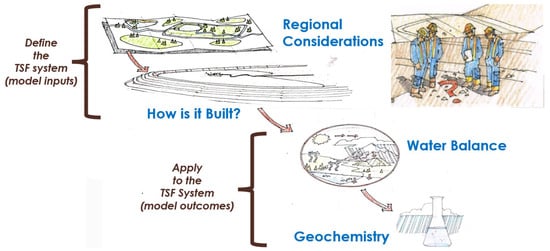
Figure 1.
Summary of the conceptual model, or tool, for predicting the evolution of metal mobility of tailings deposited withing tailings storage facilities. Illustration by Derrill Shuttleworth.
1.2. Overview of Processes
In the ecoinvent database [5], release of metals is predicted using first-order decay rates based on a landfill model, considering the total mass of tailings, metals present, and climate. Using a long-term model timeframe of 60,000 years, the current model assumes all metals will be released from a TSF. This method fails to capture key mechanistic processes within TSFs, which are thereby considered to release metals under a single, unjustified rate of control over hundreds or even thousands of years. The conceptual model presented below aims to demonstrate two important concepts: (1) measurement, or estimation, of metals in solid (their mineral) form within the tailings as a whole should not be taken as being definitive proof of their mobilization within the tailings, even when considering a timeframe of tens of thousands of years into the future; and (2) even if metals are released from their mineral form within tailings, they are not all necessarily released into the environment.
Sulfides present in sulfidic tailings, when exposed to an oxidant such as atmospheric oxygen, can release metals that are toxic in certain quantities to the receiving environment. While other toxic constituents may be released, the reaction of sulfide minerals such as pyrite and pyrrhotite with oxygen and water also results in the release H+ ions, decreasing pH, which may result in dissolution of other minerals present that were otherwise stable under more neutral pH conditions in a process referred to as ARD (or as acid and metalliferous drainage (AMD) in Australia) [24]. However, even if the pH remains neutral (buffered by carbonate minerals or silicates with sufficiently fast weathering rates), neutral mine drainage (NMD) may occur and result in elements in toxic quantities released into the environment (e.g., [25,26,27,28]). Generation of acidity and metals from sulfide oxidation, which is the key mechanism for generation of ARD in tailings, requires three key “ingredients” which can be conceptualized in a modified fire triangle (Figure 2). These include (1) a “source” of metals, (i.e., typically sulfide minerals containing elements of concern) within the sulfidic tailings; (2) “fuel” or an oxidant for sulfide oxidation reactions (i.e., molecular oxygen or ferric iron; in the case of tailings, oxygen transport into the tailings mass primarily as a result of diffusion from surficial exposed tailings material) as well as water (which may be limited under very dry climate and storage conditions); and (3) a mechanism to “transport” metals out of the TSF (i.e., water flow through advection). Without these ingredients, metals and metals may not be released into the receiving environment.
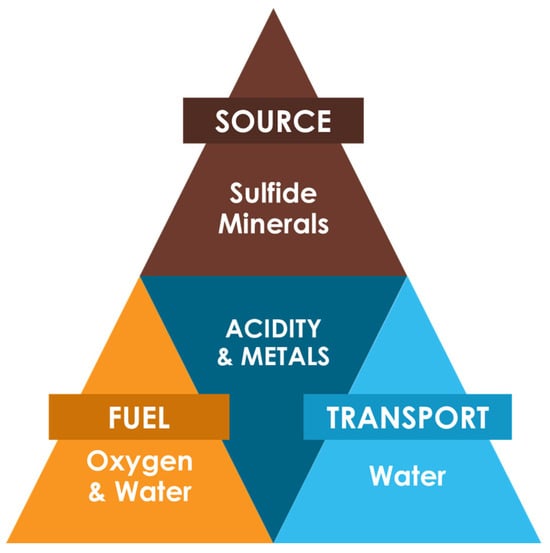
Figure 2.
Components required for release of acidity and metals from mine material storage facilities (idea adapted from presentation by Chris Kennedy).
Oxygen can move into and through mine materials by (1) advection and/or (2) diffusion. In tailings material, oxygen ingress is typically limited to that by diffusion due to their smaller grain size and partial saturation of pore space by water limiting advective airflow into TSFs [29]. Mine rock stockpiles have larger grain sizes (ranging from clay size fractions to boulders) [30] and tend to be free-draining, which allows both advective and diffusive flux of oxygen to enter the pile. This advective flux in mine rock stockpiles is partially the reason why such significant acidity and metal is released; the fuel (i.e., oxygen) for the fire (i.e., metal release from sulfide minerals) is more easily transported to greater depths, creating greater volumes of “reactive” material in terms of sulfide oxidation relative to tailings. In short, with conventional mine rock stockpiles, there is typically a nearly unlimited re-supply of oxygen for ongoing sulfide oxidation. In contrast, sulfide oxidation in tailings is self-limiting as it is controlled by the depth of oxidation and the limited flux of air (approximately 21% by volume O2) that can occur from the surface [18,31]. An added complication is that once metals are mobilized from their solid mineral form, they may be attenuated and/or re-mobilized through geochemical processes such as secondary mineral precipitation, sorption, or ion exchange processes. Other minerals reacting within the tailings can release or consume water, which may influence water availability for the sulfide oxidation reaction to proceed under systems in dry climates with water limiting cover placements.
Similarly, water will transport metals through both advective and diffusive processes; however, in the case of metals moving through a mine material storage facility, advective flux is much more effective at transporting metals through partially saturated materials. Details of how these processes interact with one another and are categorized using binning in the conceptual model approach are described in detail below, with an overview provided in Figure 3.
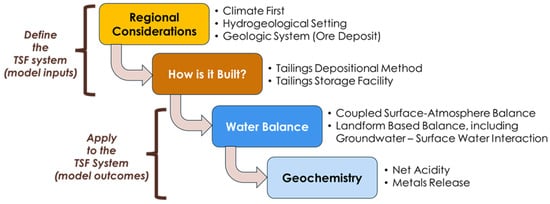
Figure 3.
Flow diagram for processes captured in the conceptual model tool.
2. Methods
2.1. Temporal Scale
To compare metal release from different TSFs globally, a meaningful timescale is required. The current timeframe for considering metal leaching used in the ecoinvent database [5] includes short-term metal leaching from tailings after 100 years, and long-term metal leaching after 60,000 years. The outcome is that for the long-term approach of 60,000 years, all metals present in the tailings are predicted to discharge into the environment. At the Society of Environmental Toxicology and Chemistry (SETAC) 34th Annual General Meeting, held in 2024 in Seville, Spain, LCA practitioners unanimously agreed that the choice of timeframe was significantly affecting results [32]. Within the mining industry, model forecasting typically extends to 100 years into the future, recognizing uncertainties of modeling beyond this timeframe (e.g., in the field of climate change science). For the purposes of this conceptual model approach, a short-term temporal scale will allow for focus on a mine’s Operations and Closure works, in a timeframe of <50 years, whereas long-term will be defined as >100 years and up to 200 years. At temporal scales greater than this, risk assessment to evaluate failure modes, rather than model forecasting, is a more appropriate tool, where the focus should shift towards drivers that manage potential failures due to the inherent uncertainties.
2.2. Binning
Binning, which is a generalized term for rounding, is also referred to as categorization, discretization, or bucketing. Binning is a data pre-processing technique, where a set of data that falls into a particular interval is replaced by a value or description representative of the interval. There is a tremendous range in potential for metal leaching from TSFs, given the global extent of their location, climatic setting, ore type, etc. In the context of the conceptual model approach presented here, binning allows the LCI database architect to focus on the importance of accuracy, versus precision. For the conceptual model, it is foundational to determine the ‘bin’ (or value) a component of the conceptual model is in, because accuracy is in reference to how close the value or measurement is to the true value. Precision is in reference to how close measurements of the same item are to each other; it is independent of accuracy and focuses on repeatability or consistency. The order in which higher-level ‘bins’ are evaluated, and details added (i.e., for (i) regional considerations, (ii) ‘how it is built’, (iii) water balance, and (iv) geochemistry), as well as the way the ‘sub-bins’ are evaluated, is central to the process. Definitions for bins selected and their ranges for each of the categories used in the conceptual model tool are provided in the sections below. Some sections of the conceptual model rely on specific input values (such as climate classification), while other bins are categorized and evaluated relatively using the following categories, after INAP [19]:
- Very Low (VL)
- Low (L)
- Moderate (M)
- High (H)
- Very High (VH)
2.3. Regional Considerations
Regional considerations include factors that cannot be controlled by engineering but are defined by the regional location of the mine site. Site-specific climate, hydrogeologic system, and geologic system provide inputs for the conceptual model approach that will influence the range in expected values for the water balance and transport of seepage out components.
2.3.1. Climate
Climate in the conceptual model tool is considered using the binning concept provided by INAP [19], which uses the Köppen–Geiger climate classification system. The Köppen–Geiger climate classification system helps characterize precipitation and temperature on a seasonal and annual basis. Both parameters are integral to understanding key physical processes that control a landform’s water balance and consequently influence net surface infiltration and oxygen ingress into a TSF. Orographic effects and climate change can also be incorporated into a site’s Köppen–Geiger climate classification to inform on TSF performance. The modified Köppen–Geiger system [33] divides climates into five major climate types based on patterns of seasonal precipitation and temperature. Precipitation, in colder conditions, is a combination of rainfall and snowfall. The five main groups are Tropical (A), Arid (B), Temperate (C), Continental (D), and Polar (E). To address the dynamic nature of intra-annual climate variability (seasonality), subtypes exist for both precipitation and temperature, which further sub-divide tropical, arid, and temperate regions, denoted by lowercase letters for both subdivisions (Table 1). Figure 4 depicts schematically the different Köppen–Geiger classifications as listed in Table 1. Any TSF can be located and characterized by its major climate type and its sub-type from seasonality of temperature and precipitation.

Table 1.
Köppen–Geiger climate classification system quantitative thresholds.
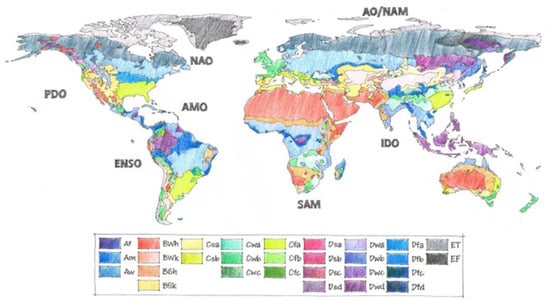
Figure 4.
Köppen–Geiger climate classification distribution [19]. Illustration by Derrill Shuttleworth.
The value of using Köppen–Geiger classification is not only in assigning a climate ‘group’ but also understanding what the climate information is telling a practitioner about how the TSF will function annually and seasonally. Effects forecasted with climate change may also result in a change in the Köppen–Geiger classification in the long-term. Questions for consideration include:
- Is there a distinct wet and dry season?
- Is cyclic wetting and drying likely, which could enhance near surface tailings oxidation in the dry season and ‘flushing’ due to surface runoff during the wet season or freeze–thaw cycles?
- Is the precipitation (PPT) and/or snow melt greater than potential evapotranspiration (PE) on an annual basis for seasonal periods, and/or for specific months of a year for the site?
- What is the anticipated drain down cycle (timeframe) and consolidation conditions of the TSF following cessation of tailings deposition?
- What is the likelihood and/or frequency of large precipitation events?
- Are drought conditions likely, which could enhance oxygen ingress?
- What are the seasonal patterns, and extent of the ambient temperature range during the year?
- Are there natural drainage (surface or seepage) paths that existed prior to construction that may be influenced by rain events or seasonal rainfall/snow melt? How are these pathways expected to have been impacted or modified through TSF construction and in the final TSF landform?
An example of how to address these questions to assess climatic considerations for a TSF situated in northern Europe is as follows: northern Europe would likely be situated in the Dfc ‘bin’, which is described using the Köppen–Geiger classification as being a ‘cold subarctic climate’, with no significant precipitation difference between seasons. The Dfc classification then informs the practitioner in respect of there being a distinct wet and dry season (in this case, there is not) and hence, cyclic wetting and drying on an annual basis is unlikely, and for seasonal periods, precipitation does not vastly exceed potential evaporation, or vice versa. This information is then used to consider effects on the geochemistry bin by providing information on depth of tailings oxidation, since the climate dictates likely wetter tailings near the surface, which will limit oxidation depth. The cold subarctic conditions will also limit rates of sulfide oxidation and net surface infiltration during periods of frozen ground conditions.
2.3.2. Hydrogeologic System
Generally, a hydrogeologic system is described as an aquifer system, which also includes the hydraulic properties and groundwater flow between groundwater recharge (topographical boundaries, such as mountains, etc.) and locations of groundwater discharge, such as springs, creeks, rivers, and artesian wells [34]. In the context of the conceptual model discussed here, the hydrogeologic system includes the TSF itself.
The ‘recoverable-unrecoverable’ seepage ratio is a key concept for evaluating and communicating the impact of the presence of a TSF within the hydrogeologic system. The ratio defines the percentage of seepage from a TSF that is collected for the purposes of managing potential adverse impact to the receiving environment, as compared to seepage that will eventually move unimpeded to environmental receptors. Villeneuve et al. [35] determined that the recoverable-unrecoverable seepage ratio for a mine rock stockpile, valley-fill hydrogeologic system to be approximately 35:65. The authors state that basal and toe seepage from the mine waste landform is strongly influenced by watershed hydrology outside the footprint of the landform, and hence the ratio of the landform’s footprint to the valley’s watershed as the landform is constructed. The relationship between seepage from mine waste and the underlying groundwater and the impacts of metals released from this seepage will be influenced by seasonality, toe seepage quantity, quality, and timing. McKeown et al. [36] illustrate the influence of the location of the groundwater table under a mine waste landform, and mounding of this groundwater table, in response to seepage emanating from the landform. Groundwater mounding under a TSF will be influenced, amongst several factors, by vertical and lateral groundwater gradients, as well as being strongly influenced by draindown, consolidation, and thus seepage, characteristics and behavior of a TSF. Vertical and lateral groundwater gradients, and the extent of a watershed in relation to run-on and runoff, can be substantially different for a TSF situated on flatter terrain compared to a TSF that is constructed as a valley fill landform. In either setting (i.e., valley fill or flatter terrain), toe seepage from a TSF typically occurs because vertical seepage from the TSF (whether it be due to draindown or consolidation) will overwhelm the groundwater system’s lateral flow capacity, thus causing a pressure response, commonly referred to as ‘groundwater mounding’. It is this groundwater mounding that most often results in TSF toe seepage, with seepage flow rates and water quality being influenced by the lateral groundwater flow conditions, as well as the TSF seepage flow conditions.
Binning within this ‘sub-bin’ allows for focus on reasonable ranges of recoverable-unrecoverable seepage ratios, from a ‘VL’ range of 10:90, to ‘VH’ at 90:10, with the ‘L’, ‘M’, and ‘H’ ranges dependent on the hydrogeologic system, as well as site-specific water management infrastructure.
2.3.3. Geologic System
Previous works have demonstrated that geologic deposit type has a significant control on total metals seen in downstream drainage quality from mine materials [37,38]. Plumlee et al. [39] argues that there are several important geological features that control the composition of both natural and mine-drainage waters, including (1) content of acid generating pyrite and other iron sulfides; (2) content of sulfides other than iron sulfides; (3) content of carbonates and other acid-consuming minerals in the deposit; (4) rock types hosting the deposit; (5) types of alteration present in the deposit host rocks; (6) nature of the ores (e.g., vein, disseminated, massive); (7) reactivity of both acid-generating and acid consuming minerals (which is a function of grain size and trace-element content in the minerals); (8) trace-element content of the deposit and host rocks; and (9) extent of pre-mining oxidation. Many of these geologic features relate to the acid producing sulfide content and presence of buffering minerals such as carbonates to neutralize H+ released. The release of H+ from sulfide minerals (lowering pH) further acts to increase the reaction rate of sulfide oxidation [40] and weathering of other minerals that may release metals. Typically, metals and metalloids are more soluble under low-pH conditions than under near-neutral to alkaline solution conditions. Under acidic pH, Fe3+ released from sulfide oxidation becomes a major oxidant of sulfides [24,41], increasing the reaction speeds further.
A commonly used guidance document by Price [42] outlines the process of quantifying sulfide minerals to neutralizing minerals through Acid Base Accounting (ABA), where the acid generation potential (AP) (calculated from sulfide mineral abundance, which release H+) is compared to the neutralization potential (NP) (calculated from buffering mineral abundance, which consume H+). In the conceptual model tool, to evaluate the effects of geologic system, AP and NP should be calculated and plotted using Figure 5, where samples classified as Potentially Acid Generating (PAG) mine materials contain insufficient buffering minerals to neutralize acidity, and Non-Potentially Acid Generating (NPAG) mine materials contain sufficient buffering minerals to neutralize acidity [42]. As a default, it is recommended to use total sulfur (S) to calculate AP (rather than sulfide content) (Equation (1)) and total carbon (C) to calculate NP (Equation (2)) [42], as total S provides some conservatism for sulfide estimation, while C may be more easily obtained in the exploration period than Sobek or modified Sobek analyses. However, minerals such as gypsum, barite, anhydrite, or other SO4-bearing salts that do not contribute to acidity, or graphite, coal, siderite, rhodochrosite, or other C sources that do not contribute to neutralization, may create errors in AP and NP calculations [42]. For this reason, mineralogy data is important to interpret results on a site-specific basis and should be coupled with interpretations. Given more detailed geochemical characterization, these measurements may be updated to site-specific measurements of AP and NP (including correction factors that consider mineralogy and/or kinetics) at a later stage.
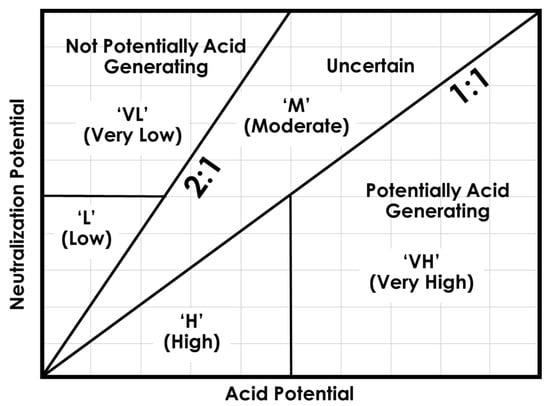
Figure 5.
Binning for tailings material based on the acid potential to neutralization potential.
The resulting binning categories ‘VL’ to ‘VH’ with respect to AP and NP are shown in Figure 5. Scale has purposely not been included for AP and NP, because the range and evaluation of ARD risk as ‘VL’ versus ‘L’ will need additional geochemical consideration to evaluate in a project or regional evaluation suitable for the LCI under consideration. Regardless, materials characterized as PAG will require some management strategy to control ML/ARD risk. The benefit of using AP and NP in an acid-base balance as an initial evaluation tool is that it allows for incorporating site-specific data, which is relatively easy to obtain during the exploration process. While mineralogy, elemental abundance, laboratory kinetic testing, and field scale kinetic data are important for characterizing mine materials (and are now often required to attain a permit to operate in many jurisdictions), this binning approach may be applied for sites early in the exploration stage to plan for managing their waste material. By using the resulting acid generation risk classification and binning, the ranges of expected SO4 and metals release based on Ficklin plots are presented by Plumlee et al. [39] and INAP [43] (Figure 6). For example, if a site’s data plots below the 1:1 slope of NP:AP, it is categorized as ‘H’ or ‘VH’, falling in the ARD range of expected metals and SO4 release (Figure 6). The deposit type has been a focus of previous LCIs [5,8] because certain deposit types (e.g., porphyry, volcanogenic massive sulfide, Mississippi-Valley type, etc.) are more likely than some other ore deposit types to contain higher portions of sulfides, low acid neutralization, and therefore result in metal release [39], and due to the accessibility of deposit type for LCA practitioners over more detailed geochemical characterization data. However, given the range of uncertainty inherent to forecasting metal release rates based on deposit type alone, knowing the deposit type alone is unlikely to capture the operational and closure risk. The binning approach using acid-base characteristics shown here allows for more site-specific classification and more accurately demonstrates the variability in potential metal release under ARD conditions where only limited data is available; additional data will be required to acquire greater precision. The tool outlined here encourages application of site-specific data to better capture metal release potential.
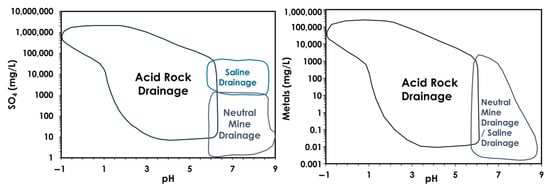
Figure 6.
Range of expected sulfate and metal release [39].
In addition to the geologic system, tailings processing methods will influence the geochemical risk of tailings contained within a TSF [44] (Table 2). To ensure consistency in comparison, whole tails should be used for initial analysis in the geologic system at the initial stage. Processing methods may be considered in later application of the tool (e.g., to evaluate risk assessment); however, it is noted that processing is often decided due to other site-specific requirements (e.g., cycloning or scavenger tails may be used for geotechnical stability and may not be critical to environmental and human-health risk).

Table 2.
Metallurgical testing of different processing methods from a porphyry copper deposit.
2.4. How Is It Built?
How mine waste landforms are constructed strongly influences how they will perform. In the context of the conceptual model, the deposition method and construction features of the TSF will be used in later sections for binning the influence on water balance and oxidation of tailings materials, controlling the production and release of ML/ARD.
2.4.1. Tailings Deposition Method
Tailings deposition methods are defined by the following categories with corresponding solid content ranges: (1) conventional low solids (or slurry tailings) (25 to 45% solids); (2) thickened tailings (50 to 70% solids); (3) paste tailings (70 to 85% solids); and (4) filtered tailings (often referred to as “dry stack”) (>85% solids) [45]. The chosen deposition method is strongly site-specific and is a function of the site plan to manage geotechnical and geochemical risk, while meeting tailings discharge mass and volume requirements for the operation. Conventional tailings discharge is typically from outfalls and spigots, located along the perimeter of the facility. Discharge of thickened and paste tailings typically occurs from a central location that is raised over the life of the facility. Dry stack tailings are typically placed using a conveyor/stacker system, or by truck.
Conventional tailings are discharged in a subaqueous or subaerial method, or some combination thereof. Subaqueous deposition can reduce the probability of oxidation of sulfide minerals in tailings, although its use is strongly dependent on water availability and climate conditions. Subaerial deposition often includes some subaqueous deposition owing to the lower solids content and lateral extent of typical TSFs. Sedimentation, settlement, and segregation of tailings particles following deposition from a spigot are strongly influenced by whether subaqueous or subaerial methods are used. In addition, characteristics of the tailings influence these behaviors as the tailings flow from an outfall, or spigot, and segregation occurs; the extent of segregation is a function of the texture of the tailings, and the density, or solids content, at which the tailings are discharged. Coarser-textured tailings will settle closer to the discharge point, with finer-textured tailings moving farther and often becoming part of the water recovery pond area (supernatant pond). The rate of tailings deposition and the extent of deposition (i.e., the number of spigots) strongly influence this behavior. Subaerial deposition will result in formation of a beach area, which remains above water, and gently slopes towards the pond. As deposition solids content increases, segregation tends to decrease as the coarser-textured tailings are ‘carried within’ the finer-textured slurry, resulting in a denser, and often more homogeneous, tailings mass.
Yield strength of a tailings mass increases as solids content increases [45]. For conventional tailings with a low solids content, most of the water is being managed in a pond, and there is very high water content in the material. Generally, though, if finer-textured material is exposed, some cracking and drying can occur, as the material becomes unsaturated. Filter tailings deposition, or dry stack tailings, is an unsaturated system at deposition because of the solids content at which the material is placed. In between is thickened tailings deposition, where there is a moderate solids content; as water drains away near surface, drying and cracking will occur.
2.4.2. Tailings Dam Construction Method
Figure 7a to c shows schematic cross-sections of upstream, centerline, and downstream tailings dam construction methods, while Figure 7d is a schematic cross-section of an upstream construction method, with downstream buttressing to support geotechnical stability. Tailings dam construction method and tailings deposition method are often chosen in combination; hence, the former also influences sedimentation, settlement, and segregation of tailings during deposition, and therefore tailings density and consolidation.
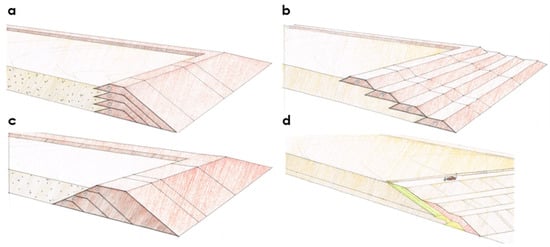
Figure 7.
Cross-section schematic of tailings dam construction methods. (a) centerline; (b) upstream; (c) downstream; (d) upstream sequentially raised tailings with downstream tailings dam buttressing. Illustration by Derrill Shuttleworth.
Binning for the tailings dam construction method focuses on ensuring that the extent of the tailings footprint is accounted for when developing an understanding of seepage volumes from a particular facility. The surface area to height ratio of the landform combined with an understanding of the TSF construction design highlights potential exposed surface areas of tailings for oxidation, which influences the total release of metals and acidity from sulfide oxidation. Additional TSF construction features may also influence other binning categories. For example, liner placement at the base of a TSF would decrease the total unrecoverable seepage (hydrogeologic system), while cover system placement during Closure might influence the water balance, if designed to divert water from entering the tailings material, or change the geochemistry if designed to decrease oxygen ingress controlling sulfide oxidation. These features of construction will be considered in answering the questions for binning materials in other sections.
2.5. Water Balance
The water balance begins to incorporate definitions of the TSF (i.e., model inputs) described in the above sections to calculate model outputs (Figure 1). Water balance calculations consider groundwater and surface water interactions, including recoverable-unrecoverable seepage ratio(s), coupled surface-atmosphere water balance(s), and landform based water balance(s).
2.5.1. Coupled Surface-Atmosphere Water Balance(s)
Basic theory and fundamental concepts of coupled surface-atmospheric water balance(s) are discussed extensively by MEND [46,47] and INAP [19]. Provided herein is an overview taken from these documents, to support discussion for how binning for the conceptual model is applied.
The near surface water balance or the ‘coupled surface-atmosphere’ water balance is affected by precipitation and potential evaporation and is a key consideration for all TSFs in all climates. Binning utilizing the Köppen–Geiger climate classification system includes the influence of seasonal precipitation and evaporation conditions, rather than simply relying on annual average conditions. The coupled surface-atmosphere water balance utilizes binning from the previous climate section to consider how these effects of climate affect the net infiltration of water into the TSF. Snowfall, as well as snow drifting and redistribution, contributes to the near surface water balance predominantly during spring melt. In colder regions, snowmelt may occur for a shorter and more intense duration as compared to temperate climates, as peak melt occurs during periods of warm temperatures and high net radiation. Dependent on frozen ground conditions, water content of the near surface material, and topography, snow melt can primarily report as surface runoff; however, the extent and design of the landform as to whether the runoff will result in ponding at another location on the landform, and thus infiltration at the other location. Sublimation may need to be considered in the near surface water balance in areas that are seasonally snow-covered.
The principal phenomenon of interest in understanding near surface water balance for a TSF is the transient flow of water within the unsaturated zone. The primary issues for consideration are mechanisms (and site-specific controls on these mechanisms) responsible for storage and movement of water in unsaturated tailings. The two fundamental relationships that define the movement of water in the unsaturated zone are the water retention curve (WRC) and the hydraulic conductivity function (k-function). The WRC is critical to understanding water movement as it describes the relationship between the energy state of pore-water within the tailings (matric suction, or negative pore-water pressure) and the volume of water stored within the tailings pores (volumetric water content). Figure 8 shows typical WRCs for finer- and coarser-textured materials. The negative pore-water pressure required to initiate drainage of an initially saturated material is referred to as the air-entry value (AEV).
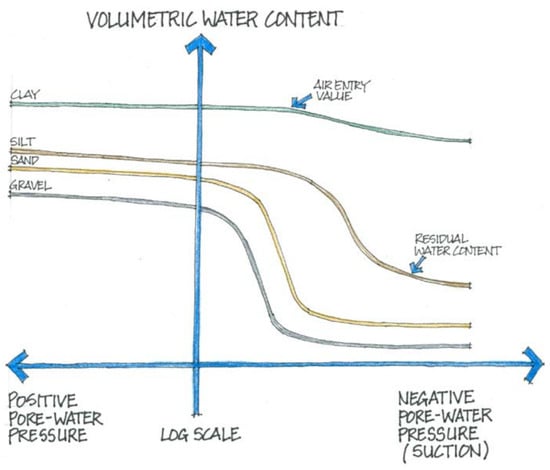
Figure 8.
Water retention curves for typical material types (from MEND [47] and after Freeze and Cherry [34]). Illustration by Derrill Shuttleworth.
A finer-textured material can retain water under higher suction values compared to a coarser-textured material with smaller pore-sizes. Hence, a coarser-textured material starts to drain first (i.e., it has a lower AEV) as suction increases from initially saturated conditions. The slope of the WRC after the AEV is also a function of the texture of the material; the pores of well-graded materials gradually drain as suction increases, resulting in a more moderately sloping WRC for a well-graded material as compared to a uniform textured material. In the context of tailings material, more homogeneous tailings, for example deposited as thickened tailings, will have a higher AEV and a more moderately sloping WRC, as compared to conventionally deposited tailings. As suction increases, the tailings materials drain until the residual water content is reached. The residual water content is the relatively flat portion of the WRC, where large increases in suction result in exceedingly minor changes in water content. At these water contents, water movement is predominantly water vapor flow.
Hydraulic conductivity (which is closely related to the concept of intrinsic permeability) [34] is the material property that characterizes the ability of the material to transmit fluid. Water will move through the material in response to energy gradients; mechanical energy gradients (i.e., total head, which comprises pressure head and elevation head), but also due to thermal, electrical, or chemical gradients. The flow of liquid water in response to mechanical energy is defined by the relationship between a unit flux of water and the energy gradient, and is commonly referred to as Darcy’s Law (Equation (3)):
where q is the unit flux of water (m3 s−1 m−2, K is hydraulic conductivity (m s−1) and i is the energy gradient, represented by the change in total head with position (dh dx−1, unitless) [34]. Both h and x are represented in units of length, although hydraulic head represents the energy per unit weight of water.
q = Ki
Darcy’s Law is applicable to saturated and unsaturated material. However, hydraulic conductivity of a saturated material is taken as a constant, for a given density or void ratio, whereas for unsaturated conditions, hydraulic conductivity will change as a function of matric suction, as shown in Figure 9. The rate of water flow within the tailings mass (i.e., pore-water velocity) is determined by the unsaturated or saturated hydraulic conductivity and the volumetric water content (Θw) of the tailings material, as per Guymon [48] (Equation (4)):
υ = K Θw−1
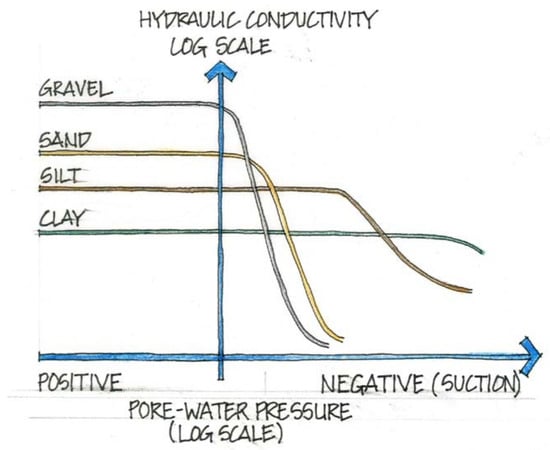
Figure 9.
Hydraulic conductivity (K) curves for typical material types (from MEND [47] and after Freeze and Cherry [34]). Illustration by Derrill Shuttleworth.
The pore-water velocity is a critical consideration for advective movement of solute in tailings pore-water, arising from gravity driven drainage within the TSF.
In temperate climates the near surface water balance tends to be focused on hydrology alone, during periods of the year in which air and ground temperature is above zero. For these conditions, the thermal regime has little influence on water balance, unless the site is not vegetated, and evaporation (rather than transpiration) dominates water loss to the atmosphere. In colder regions, hydrology is strongly influenced by distribution and timing of snowmelt, which is in turn strongly influenced by slope and aspect (radiation), snowpack accumulation, snow melt, material characteristics, and antecedent water content prior to freeze-up.
The near surface water balance is described as a ‘coupled’ system because the surface energy balance will influence the water balance. Energy is contributed to the surface from incoming short- and long-wave radiation, heat from the phase change in water, and conduction of heat from the surrounding near surface material. Energy is removed due to outgoing radiation, heat removed from the phase change in water, and conduction of heat to the surrounding near surface material.
The coupled surface water balance, in combination with unsaturated zone hydrology, results in water evaporating at the potential evaporation rate when a tailings surface is saturated, but at a reduced rate (i.e., the actual evaporation rate) when the material is unsaturated. For these conditions, rainfall (or snowmelt) can infiltrate the tailings material near the surface, be stored, but then evaporate following cessation of the rainfall or snowmelt event. Hence, near surface tailings water content may change, but net surface infiltration deeper into the tailings mass is negligible.
Understanding of the coupled near surface-atmospheric allows binning to be applied on a site-specific basis; net surface infiltration rates into a TSF landform (for bare surface, or ‘pre’ reclamation conditions) and net percolation rates into a TSF landform (for reclaimed conditions) are binned into ‘VL’, ‘L’, ‘M’, ‘H’, and ‘VH’ rates. Based on the Köppen–Geiger classification for a site, INAP [19] provides a range of intervals for net surface infiltration (or net percolation) depending on texture of the near surface mine waste landform material or reclamation cover system type (considering layering, texture, thickness, and vegetation) (Figure 10). For example, the ‘VL’ range for net percolation for a reclaimed mine landform situated in a Bwh Köppen–Geiger climate (a ‘hot desert climate’) would be less than 1% of average annual precipitation, with the ‘L’ range being 1 to 5%, and so on for the ‘M’, ‘H’, and ‘VH’ ranges. In this climatic setting, there is a high probability that net percolation for a reclaimed mined landform will be less than 1% of average annual precipitation for any given year. In contrast, for a similar reclaimed mine landform situated in an Aw Köppen–Geiger climate (a ‘tropical wet savannah climate’), the ‘VL’ range would be in the less than 5% of average annual precipitation, with the other ranges up to ‘VH’, adjusted accordingly. For additional details for the binning under various climate scenarios, see INAP [19].
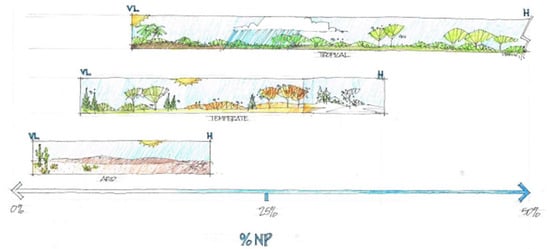
Figure 10.
Range of ‘VL’ to ‘H’ for ‘NP’, or net percolation, depending on climate [19]. Illustration by Derrill Shuttleworth.
2.5.2. Operational Versus Closure Water Balance(s)
During Operations, active tailings deposition, particularly for conventional and thickened tailings deposition, introduces a substantial volume of water, that otherwise would not be available, or part of a near surface or landform water balance. Drier tailings beach areas will have lower evaporation rates but also have the capacity to accept rainfall and snowmelt as surface infiltration to be stored for future evaporation or infiltrate deeper into the tailings mass. Wetter tailings areas will evaporate at or near the potential evaporation rate, and have limited capacity to infiltrate water, and thus result in runoff or ponding in response to rainfall and snowmelt events.
Seepage resulting from draindown and consolidation of tailings during Operations will be relatively constant, for a given tailings footprint area and thickness. However, seepage due to draindown and consolidation will decrease, typically on a logarithmic basis following cessation of tailings deposition.
A reclaimed tailings surface, and/or one that has surface runoff conditions managed for Closure, will often reduce net surface infiltration into a TSF, thus reducing fluctuation of the pore-water regime in the tailings mass (and thus the phreatic surface). The net effect is a reduction in tailings footprint seepage rates due to the difference in the hydraulic gradient driving seepage from the facility.
In this respect, binning to account for Operations versus Closure water balance(s) will include changes in the ranges described for the same TSF for operational conditions, as compared to closure conditions (e.g., rather than a net surface infiltration rate for an operational TSF being in the ‘M’ range, it might decrease to the ‘L’ or ‘VL’ range, depending on the extent of reclamation effort).
2.5.3. Landform Based Water Balance(s)
Devito et al. [49] discuss the critical importance of surface water connectivity across a landform, or landscape (Figure 11). Despite a TSF generally considered to be ‘flatter terrain’ on a tailings plateau surface, because of TSF construction methods and tailings deposition characteristics, a tailings surface does generally include relief, as well as areas that are locally lower, and higher, in topography. This results in a varied system of higher and lower connectivity in respect of surface water. Hence, other than dry stack tailings, ponds are generally used to manage supernatant water during operations, as well as ephemeral conditions for closed TSFs.
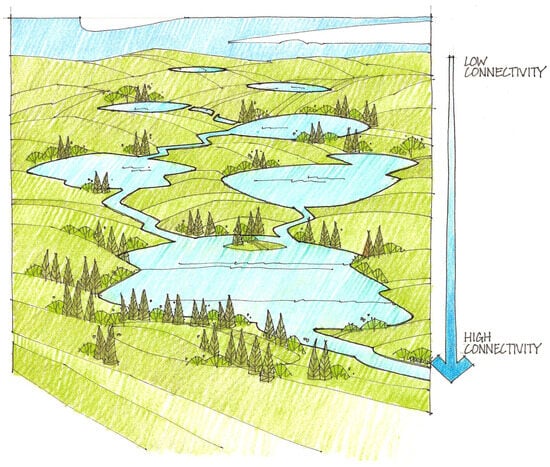
Figure 11.
Connectivity across a landscape or landform from low to high connectivity [50]. Illustration by Derrill Shuttleworth.
The critical factor to consider is: because of these conditions, does surface runoff have the capacity to ‘leave’ the landform? Specifically, on micro-scale (or point scale), does the surface of the tailings material cause saturated overland flow in response to rainfall or snowmelt, or surface runoff as a result of the rainfall or snowmelt exceeding infiltration capacity? If there is insufficient connectivity to remove surface runoff from the landform, which is often the case for operational TSFs due to a need to manage the environmental design flood (EDF) and the inflow design flood (IDF); runoff on a micro-scale will influence the TSF landform’s pore-water pressure regime.
This is depicted on the left-hand side of Figure 12, where a higher phreatic surface is the result. In this case, the higher phreatic surface will increase the driving hydraulic head influencing seepage rates from the footprint of the TSF. The depth to the phreatic surface, or water table, influences reclamation construction methods, but also in-service performance. For deeper water table positions, the probability of tailings pore-water constituents moving into overlying material reduces, depicted schematically in Figure 12. Water table depth below the reclaimed area of the tailings will also influence reclamation performance; despite unsaturated conditions, pore-water may still be available to satisfy plant-water use needs.
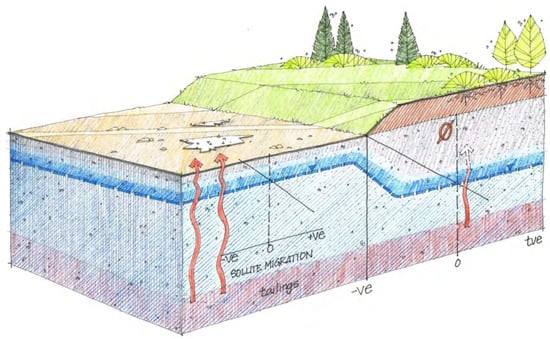
Figure 12.
Influence of operational and reclaimed tailings surface on position of the tailings landform water table, and in turn on solute migration [19]. Illustration by Derrill Shuttleworth.
Binning for this ‘sub-bin’ focuses on likely water table positions arising from climate conditions, tailings material texture, TSF construction methods, tailings deposition method, and a TSF’s surface water management approach. These considerations will influence the response of the TSF and thus influence where the net surface infiltration rate is in the ‘VL’ to ‘VH’ range. These conditions also influence whether sulfide oxidation will be in the ‘VH’ to ‘VL’ range, because all these conditions influence in situ near surface saturation conditions (i.e., the near surface water content). Additionally, inputs from the hydrogeologic system considering the recoverable-unrecoverable seepage ratios (that combine with ‘how is it built?’ considerations such as drainage ditches and pumping) will be model outputs from this section, as the total quantity of water leaving the TSF will influence the metals that enter into the receiving environment.
2.6. Geochemistry
In the geochemistry section, the conceptual model will combine the binning defined previously by the geologic system and reaction sub-bins, including oxidation potential, attenuation factors, and bins from the water balance section defined above. The final output of the conceptual model will be a binning of net acidity and metals release from the TSF.
2.6.1. Oxidation Potential
As defined by the geologic system, materials are either ‘potentially’ acid generating or not. The potential part infers that an oxidant is required to begin the reaction of sulfide oxidation (Figure 2). Oxygen ingress into finer-textured materials, such as tailings, is dominated by diffusion across exposed surfaces [51]. Diffusive flux can be described by Fick’s first law (Equation (5)):
where is the gas flux (mol m−2 s−1), is the effective diffusion coefficient (m s−2), is gas concentration (mol m−3) and is depth (m). is a function of porosity, saturation, and the free phase diffusion coefficient; lower porosity and higher water saturation corresponds to lower for the gas phase [52].
Oxygen ingress is therefore typically limited to shallower depths within a tailings profile, particularly for high saturation conditions and finer-textured tailings material, which can retain a higher degree of saturation when unsaturated [53]. Increased saturation or decreased porosity, representing a denser material in terms of decreased porosity, acts to limit sulfide mineral oxidation by limiting oxygen flux and therefore activity (concentration), as shown in the example of pyrite oxidation by oxygen (Equation (6)):
When oxygen is available in the pore spaces, depending on sulfide mineral reactivity, shallower sulfide mineral oxidation may rapidly consume oxygen entering the tailings through diffusion, limiting availability of oxygen to react with sulfide grains at depth. Conceptually, this process is self-limiting, as diffusion rates decrease with increasing depth of the oxidation front (i.e., the concentration gradient decreases), which travels slowly downwards as sulfide minerals are consumed near the surface (Figure 13a). Adversely impacted tailings pore-water is first focused above the oxidation front, where the acidity generated is a function of exposure time, tailings reactivity, water content, and surface area.
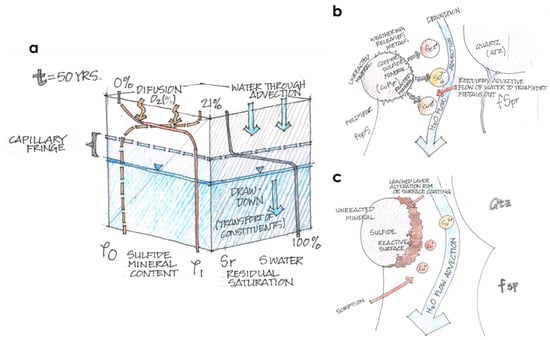
Figure 13.
Conceptual model for sulfide metal oxidation and metal release in tailings; (a) demonstrates the relationship between O2 and sulfide oxidation fronts, where products of mineral weathering processes are transported downwards through advection; (b) shows at the pore scale how this process of sulfide oxidation releasing metals occurs and are picked up by advective water flow; (c) conceptualizes how some of the metals released then are either sorbed or precipitated to become immobile, so as not all metals released from sulfide oxidation are then transported outwards, though other factors such as biological attenuation or reductive dissolution (not pictured) may also act to immobilize metal release. Illustration by Derrill Shuttleworth.
Foundational to the conceptual model presented herein is that it is very unlikely for the entire tailings profile to become oxic over the next few centuries, particularly if tailings remain tension saturated, or saturated. This mechanistic process of limited O2 depth has been shown in the field and through numerical modeling studies [31,54] yet is missing in the current ecoinvent database [5], where long-term predictions dominate LCIAs assuming that all metals present in the TSF are released. Rather, the conceptual model tool bins the active oxidation depth based on considerations of the surface area to height ratio previously defined, as well as reactivity and hydraulic properties to estimate an oxidation zone depth to quantify the zone of ‘reactive tailings’. Consideration of the reactive tailings volume, rather than all the tailings volume, incorporates ‘reasonable expectation’ conceptual model for tailings oxidation that includes mechanistic processes (e.g., including diffusion limitations and oxygen consumption by sulfide oxidation).
2.6.2. Attenuation Along Flow Paths
Over time, as a result of net surface infiltration, a largely vertical pore-water pressure response in the tailings mass eventually leads to basal seepage from the TSF landform (Figure 13b). Acidity generated from an exposed tailings surface during tailings deposition, or following cessation of tailings deposition, can be transported downward through the landform, where the water quality of basal seepage is influenced by solids and pore-water chemistry along the flow path. The time for this seepage to reach the landform’s base will be a function of the flow path length (i.e., facility height) and pore-water velocity. Draindown seepage from consolidation may also contribute to seepage rates, depending on site-specific conditions and engineered barriers, if any exist. It can take decades to centuries for adversely impacted pore-water to reach the landform’s base via essentially vertical, porous-medium flow through mature tailings with thicknesses of several tens of meters [55]; therefore, in most cases, surface runoff is the primary pathway for release of net acidity and metals during Operations and in Post-Closure. Surface runoff is typically managed through maintaining sufficient water storage capacity, collecting runoff as it occurs, and treating the surface runoff water as required. This timing aspect of the conceptual model highlights the importance of surface runoff management from TSFs to water stewardship at mine sites, and the necessity to consider capture and treatment measures in place that mitigate potential impacts on the receiving environment.
Figure 13c depicts schematically how chemical precipitation, and sorption can attenuate net acidity and metals release from the base of a TSF landform. Attenuation capacity will be greater for ML/ARD where significant alkalinity exists; alkaline amendment (including lime neutralization remains a widely accepted treatment method for this reason). However, neutralization will not work to attenuate all metals to levels set by regulation to protect the environment, and is ineffective for some (e.g., As, Se, Mo). Biological attenuation, which will also influence metals release from the base of the TSF landform [56] or reductive dissolution processes that then release attenuated or sorbed species may also act to immobilize metals. Attenuation methods are binned as ‘VL’ to ‘VH’ depending on the specific metal, neutralizing potential in the tailings path from the oxidized zone, hydraulic residence time for attenuation to occur, and other physical or chemical properties of the material. Attenuation capacity is therefore site-specific and can often only be detected at the field-scale, therefore without field-scale studies for the site or an analog site, conservative underestimation of the potential attenuation capacity is often assumed for mines lacking this available data.
2.6.3. Net Acidity and Metal Release
The key message from the conceptual model approach is that even if net acidity and metals release results from near surface tailings sulfide oxidation, these products must move down through a tailings mass due to advective flux. Attenuation mechanisms can limit metals release, and thus not all metals released from sulfide oxidation will emanate from the base of the TSF, and those that do will not represent the total mass of metal content in the tailings. Measurement or estimation of metals in solid (their mineral form) within the tailings as a whole should not be understood as being certain to mobilize within the tailings, particularly when considering a timeframe of tens of years, to even perhaps centuries into the future. Instead, a geochemistry component of an evaluation of metals release from a TSF, must be evaluated considering the previously defined bins for regional considerations, how the TSF is constructed, water balance, and geochemistry. The conceptual model tool proposed here uses the same approach as per INAP [19], in binning net acidity and metal leaching using the categories of ‘VL’ to ‘VH’. The bins indicate the probability that net acidity and associated metal leaching of a particular metal will be in that range for the TSF for any given year, where net acidity is a function of the concentration of dissolved metals, pH, and alkalinity. Following steps in LCIA can then determine ecotoxicological impacts arising from metals entering the receiving environment, though the range of certainty is dependent on data available to make this assessment as defined in previous sections. Additionally, the definition of the bins as probability of net acidity and metal leaching on an annual basis provides the opportunity to evaluate for Operations versus Closure time periods, where often measures are in place to manage mine impacted waters during the Operations period that may change when the mine is in Closure.
3. Case Studies
To test the conceptual model approach, three mine sites are evaluated, including: (1) Faro Mine, a historical lead-zinc mine located in the Yukon, Canada, and two unnamed site tailings storage facilities; a copper mine located in Northern Europe and a multi-metal mine located in Canada. Case study sites were selected to ensure a range of climate, geologic and hydrogeologic conditions were captured. It was also important that these sites were studied extensively and provided data available in the public domain to ensure the accuracy of forecasting made with the conceptual model tool could be verified. These site’s TSFs provide a proof-of-concept for the conceptual model approach; such that additional examples from the industry and further updates to improve the database and support for the archetypes used in the tool are warranted.
3.1. Faro Mine
The Faro Mine, located in South-central Yukon, Canada near the town of Faro and on the traditional territory of the Kaska Nations and upstream from Selkirk First Nation, was once the largest open pit lead-zinc mine in the world, producing 70 Mt of tailings, stored within the Rose Creek Tailings Area. The mine was abandoned in 1998 and is now under care and maintenance by the Government of Canada [57]. Geochemical characterization data and porewater chemistry from [58,59] are compared to groundwater samples [60] several decades after tailings placement to test the application of the conceptual model tool. Faro Mine is one of the most complex abandoned mine remediation projects in Canada [57], has been extensively studied [59,60,61,62,63,64], and provides field-scale water quality data several decades after deposition.
3.1.1. Regional Considerations
The Köppen–Geiger climate classification for Faro is Dsc, or continental ‘subarctic climate’. This climate is dominated by the winter season and long cold periods with short, clear days. Low precipitation often occurs in the form of snow (320 mm−1 year). Snow melt is therefore the main contributor of recharge, and there is relatively low humidity on site. The Rose Creek Valley Aquifer, composed of glaciofluvial sediments, underlies the Rose Creek Tailings Area, which is unlined and hydraulically connected to the aquifer. Site layout, including flow of groundwater is shown in Figure 14. The hydrogeologic system is characterized as a valley fill deposition. Hence, given the hydrogeologic setting, and the strong lateral hydraulic gradient in the underlying aquifer (see Figure 14), we estimate that the ‘un-remediated’ recoverable-unrecoverable seepage ratio is in the ‘VL’ range, or ~40%–60%. The remediation plan for the site includes a series of ‘pump-back type’ seepage collection systems downstream of the TSF, with a goal of recovering >99% of TSF seepage for treatment. Hence, following remediation, we would characterize the recoverable-unrecoverable ratio as being in the ‘VH’ range, or ~90%–10%.
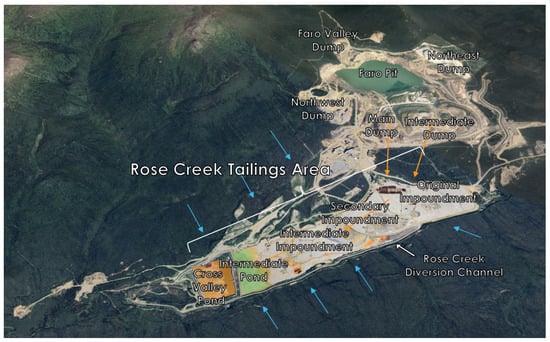
Figure 14.
Faro Mine site layout featuring the Rose Creek Tailings Area. The blue arrows indicate groundwater flow directions; orange indicates mine impacted groundwater flow. Figure created using Google Earth Pro version 7.3.6.10201 and groundwater flow maps from the Faro Mine Remediation Project [57].
The geologic system is characterized as a lead-zinc Sedimentary Exhalative (SEDEX) deposit; SEDEX systems are particularly susceptible to acidity generation because of the abundance of sulfide minerals present combined with a paucity of minerals, such as calcite, that provide reactive neutralization. Ore at Faro typically contains 0 to 4.8% total S, with an average of 0.25% [60]. Sphalerite, galena, and pyrite are the most abundant sulfides, with pyrrhotite, chalcopyrite, and marcasite in lesser abundance, with trace amounts of tetrahedrite, bournonite, and arsenopyrite. Gangue minerals including barite, magnetite, and barium-iron carbonates are also present [60]. Due to the high sulfide content and low neutralizing potential, the tailings materials are classified as PAG, ranging from ‘H’ to ‘VH’ (Figure 15), and fall in the range of ARD in the SO4 and metals release plots (Figure 6). Exposed tailings are acid-generating, with pH < 2 at the surface [59].
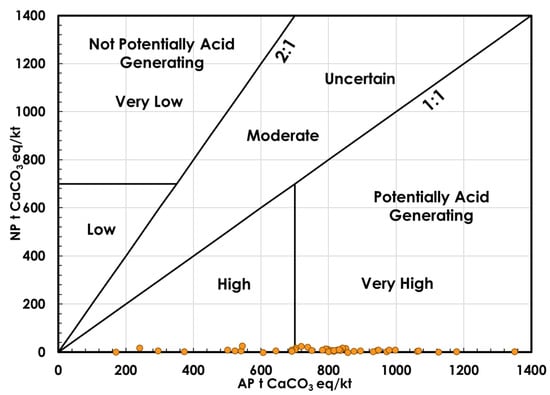
Figure 15.
Faro tailings samples [58] plotted for binning categorization based on the acid potential to neutralization potential.
3.1.2. How Is It Built?
In the Rose Creek Tailings Area, 28.6 × 106 m3 of tailings were deposited as a slurry over a surface area of 195 ha, with an average height of 15 m [61]. The surface area to height ratio is 5 × 107:1, which allows for significant amounts of tailings in the thin but aerially extensive deposit to be exposed to oxygen over time through diffusion. The Down Valley Seepage Interception System (which consists of four lines of groundwater capture and monitoring) as well as the Emergency Tailings Area Seepage Interception (three lines of surface and groundwater capture) are used to collect contact water from all sources in the Faro Pit, which are sent to the Water Treatment Plant on-site before discharge to Rose Creek [62]. The Rose Creek Diversion Channel, Intermediate Pond, Cross Valley Pond, and North Wall Interceptor Ditch were all part of mine construction to control mine-impacted water and currently influence groundwater through the Rose Creek Tailings Area [52].
3.1.3. Water Balance
At the surface, we estimate recharge into the tailings (as net surface infiltration) being in the ‘M’ range, 15 to 25% of average annual precipitation. Tailings were deposited as a slurry and situated in a climate with low evaporation conditions. Therefore, water storage capacity in the tailings material is considered ‘L’. Porewater velocity may be considered as being ‘L’ to ‘M’ given the hydraulic conductivity of the tailings ranges from 1.4 × 10−9 to 2.0 × 10−5 m s−1, with a median of 2.2 × 10−7 m s−1 [60], ranging between finer- and coarser-textured tailings. As noted, we estimate the cross valley fill recoverable-unrecoverable ratio is in the ‘VL’ range, or ~40%–60%. Significant amounts of solutes released by the tailings may be lost downstream into the Rose Creek Aquifer. Downward vertical hydraulic gradients have been observed within the tailings, though there are four artesian wells downstream at the base of the Cross Valley Dam [60]. Remediation planning of the TSF is in progress at the time of writing.
3.1.4. Geochemistry
The geologic system binning suggests the geochemical risk for the Faro tailings are ‘H’ to ‘VH’. To bin the actual release of metals from the TSF, additional geochemical data combined with the construction and water balance of the Rose Creek Tailings Area are considered.
Depth of oxidation into the tailings at Faro is between 0.75 and 1.0 m, where the highest concentrations of SO4, Fe, Mn, and other metals are present [58,59]. Due to the high surface area to height ratio, this results in more reactive tailings oxidizing than would be expected if the tailings were buried deeper or had a higher water table or cover system to limit oxidation. Sulfate, Fe, Zn, and other metals propagate downwards from this zone, though some constituents (such as As, Co, Cr, Cu, Ni, and Zn) which are significantly higher in the oxidation zone, are attenuated along the flow path [59]. Tailings pore water below the water table, as well as pore water within the underlying Rose Creek aquifer are neutral (pH > 6) due to the presence of carbonates and significant alkalinity within the aquifer that react with sulfide oxidation products. Attenuation capacity is classified as ‘M’; while neutralization capacity and attenuation are evident along the tailings profile, aquifer carbonates that neutralize acidic waters are being depleted over time [60] and water quality at Faro is expected to worsen for the next 400 to 600 years [63].
Pore-water samples collected in 2020 [58,59] are plotted shown in Figure 16 compared to groundwater samples collected in 2012 [64], though concentrations in the Rose Creek Valley Aquifer below the Cross Valley Dam have been steadily increasing in groundwater monitoring data measured since 2002 [60]. In the water and load balance model, it was noted that Zn transport lags significantly behind SO4, where the attenuation and chemical reactions causing the retardation of Zn are not well understood [65]. To complicate groundwater quality findings, water quality down gradient of the Cross Valley Dam flowing under the tailings includes groundwater originating from under the Main Dump, Intermediate Dump Emergency Tailings Area and Mill Area. As the mine rock is also a significant source of contaminant loads [66], the additional point source loads act to worsen water quality collected down gradient of the TSF, in addition to solute loads from the tailings. Sulfate loads into Rose Creek have increased from 2300 t year−1 in 2006 to approximately 5100 t year−1 in 2016, with an expected 66% of this sourced from toe seepage at the Cross Valley Dam [65], while Zn loading has increased from 0.7 t year−1 to 5.3 t year−1, though only 1.2% of this is estimated to come from the Rose Creek Tailings Area. Overall, the long-term classification of Faro’s net acidity and metals is ‘VH’ due to the fact that a significant volume of the tailings containing high sulfide content that are exposed to oxygen, which are anticipated to continue to produce worsened water quality over the next several centuries. Unless solutions to this complex historic site are found to mitigate contaminant release, Faro will likely see adverse impacts long-term on the downstream receiving environment.
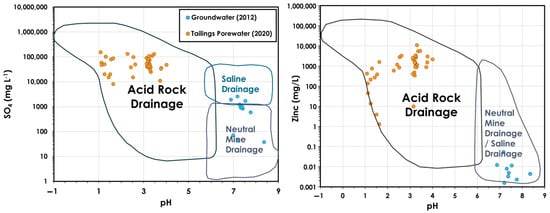
Figure 16.
Faro tailings porewater [58] and groundwater concentrations [64] of sulfate and zinc versus pH.
3.2. Additional Mine Site TSFs
Table 3 compares the primary and sub-binning for the three case studies. For confidentiality reasons, the mine sites for the following two case studies will be referred to as Site A and Site B. Although additional details for Site A and Site B could not be provided and sourced with the detailed description of the Faro Mine to maintain anonymity, comparisons made in Table 3 provide an overview of the data required and consideration necessary to appropriately categorize and use the binning approach presented for the conceptual model tool. As shown in Figure 3, the model inputs are defined by the first two bins (regional considerations and how it is built), while the following two bins (water balance and geochemistry) are applied to define the model outcomes. A final net acidity and metals release categorization is determined from the model outcomes for metals leaving the TSF. In Section 1.2, it was noted that the conceptual model approach aims to demonstrate that the release of metals from a TSF requires that both (1) the metals must be released from their stable mineral form; and (2) there must be a transport mechanism to move metals from the tailings outwards into the environment. The model outputs of water balance and geochemistry help answer these two requirements to ultimately categorize the net acidity and metals release.

Table 3.
Comparison of primary and sub-binning for the three case studies.
At Site A, the Köppen–Geiger classification is Cfb, where cool summers and mild winters result in moderate precipitation. The net surface infiltration recharge into the TSF is >60% of average annual precipitation, which is ‘VH’. Similarly to the Faro TSF, the underlying aquifer and hydrogeologic conditions of Site A’s TSF result in the un-remediated recoverable-unrecoverable seepage of 40%–60%, which is categorized as ‘VL’. With respect to the geologic system, volcanic massive sulfide deposits are often associated with high ML/ARD [39], where ABA results categorize the tailings as ‘VH’ for ARD potential. Current attenuation factors, as well as strategies to manage metal release at this site, are unknown and were therefore categorized conservatively (Table 3). At Site A, the combination of the ‘VH’ geochemistry categorization (Figure 5) (i.e., metals will be released from their mineral form in excess) with the ‘VL’ recoverable-unrecoverable seepage ratio (i.e., metals have the potential to be transported out of the TSF), results in a final categorization for net acidity and metals release risk is ‘VH’ for the un-remediated TSF. Similarly to the Faro Mine case study, without long-term management strategies in place, Site A will have long-term environmental liabilities associated with ML/ARD from the TSF.
Site B’s porphyry copper deposit type is also a sulfidic deposit type associated with high risk of ML/ARD [8], and ABA results categorize the site as ‘VH’ ARD potential. Like the Faro Mine, Site B also lies in the Dfc Köppen–Geiger classification and has a low annual precipitation, however net infiltration at Site B is somewhat higher (classified as ‘H’) than at the Faro Mine, between 20% and 40% depending on water table height and texture of the tailings. Although both are classified as Dfc, measured precipitation and snow melt are higher at Site B. Despite the higher categorization of net infiltration, Site B’s TSF is currently designed so that discharge flows are collected within diversion channels and directed towards the pit; this results in a ‘VH’ recoverable-unrecoverable seepage ratio of around 90%–10%, since most of the seepage is collected rather than entering the receiving environment. The design of the TSF to manage discharge limits the amount of impacted water moving to the receiving environment. Although the potential for metal leaching is ‘VH’, since the transport outwards is limited, the final categorization for Site B is ‘M’ for net acidity and metals release risk.
4. Discussion
The conceptual model approach presented in this study demonstrates how complex mechanistic processes within TSFs result in variability of metal release from different TSFs. There is no tool or model available in current practice that can accurately quantify the release of metals with confidence without available data to calibrate and constrain the model, including databases of LCI data developed to date. As demonstrated in this outline of the conceptual model approach, the mechanistic processes occurring within the TSFs control the metals released and transported outwards. Relying on statistical methods alone (such as in the current Doka model [5]) is likely to miss these nuances and may lead to biases based on ore type or geographical location (which may historically have seen worse management practices for tailings). Furthermore, the conceptual model approach and case studies demonstrate how release of metals on shorter timeframes (from decades to several centuries) may be more meaningful than simply assuming all metals will eventually be released (after 60,000 years [5]). While a mechanistic approach in other studies has argued for using reactive transport models to quantify metal release from tailings (e.g., [8,9]), these complex models often require significant runtimes and data to calibrate (such as kinetic results to determine mineral reaction rates and site-specific mineralogy), which may be unavailable. The conceptual model approach has been designed to rely on model inputs that will be necessarily available prior to construction of a TSF, and which should have been collected by the mining company to evaluate economic feasibility and obtain necessary permits to open a mine (including decisions such as whether water treatment facilities or alternative construction design is necessary to decrease risk of metal release and/or address geotechnical stability concerns). In early phases of mine life, data necessary to validate the forecasted metal release categorization from the conceptual model approach will not be available. The approach does not prevent use prior to obtaining this data; rather, the outputs will instead span a larger range of potential values and metal release rates possible at that specific site. This uncertainty will decrease as additional data becomes available, improving the precision of anticipated metal release rates. However, even with site-specific data measurements decades after TSF construction, measured concentrations from pore water in the TSF or underlying groundwater may range over several orders of magnitude, as seen in the Faro Mine case study (Figure 16).
Case studies of established TSFs in Section 3 support that the conceptual model approach produces model outputs that fall within expected categorization outputs described in Section 2 (Figure 16, Table 3). While case studies have been provided to walk through how the conceptual model approach would be applied, development of new LCIs will require further application by LCA researchers and practitioners (e.g., assembly of data including additional case-studies of sites to validate the model across a broader range of climate, geologic, and hydrogeologic conditions, under different TSF construction designs). To further validate this approach, we advocate for collaborative efforts with industry and other stakeholders to conduct additional case studies, utilizing non-disclosure agreements where appropriate. Once sufficient confidence is established, the conceptual model approach could be employed to develop an LCI solely from publicly available data. With additional site data to expand the dataset, it is recommended that the approach be further developed considering statistical analysis to set binning thresholds, while still maintaining binning using fuzzy logic to represent a range before selecting a consistent approach to represent those ranges with an explicit quantification of metal release rates. While the binning approach does rely on previous studies which include a larger range of case studies (e.g., the Köppen–Geiger classification system, or the range of geologic systems influencing metal release by Plumlee et al. [39]), quantification of categorization using this approach should be supported through uncertainty or sensitivity analyses in the context of the conceptual model approach. While the conceptual model approach may be useful for brainstorming ideas for site-specific management strategies at this stage, advancements using statistical analysis and more sites with variable model inputs is a necessary next step to building sufficient confidence in the model’s outcomes for use in developing new databases of LCI data. For example, the categorization of net acidity and metal release in the case studies provided (though from variable geologic deposit types) were all classified as ‘VH’ sulfide oxidation potential. It will be necessary to test ‘VL’, ‘L’, and ‘M’ risk deposit types to confirm that the final influence on net acidity and metal release rates (when considering all the mechanistic factors together) is fitting.
It is acknowledged that the large range of metal release rates possible may contain challenges for scoring in LCA in that explicit flows will need to be quantified, but it should bring attention to the degree of uncertainty that is unavoidable when estimating future metal release rates from mine waste facilities to LCA practitioners, and highlight the need for collaboration with mining industry professionals for the development of such tools. Additionally, while the focus of the conceptual model approach is to define metal release through seepage, other factors may be important to consider in the overall scoring within the LCA (such as dust emissions, benefits from revegetation or carbon sequestration, or social factors such as land use from the TSF placement [67]). Furthermore, while examples of groundwater concentrations were provided from the Faro case study for reference, the conceptual model approach’s boundary conditions surround the TSF (i.e., seepage water quality). The fate of mine-impacted waters beyond the TSF (such as aquifer or freshwater body connectivity and size, habitat sensitivity, etc.) will be important considerations for assessing ecotoxicology and downstream impacts. The conceptual model approach may be advanced through collaboration with industry partners and LCA researchers to incorporate these considerations when advancing towards provision of better LCIs.
As in other areas of LCA where uncertainty is high, there is benefit in the approach’s capabilities to highlight these uncertainties using a semi-quantitative range of potential metal release. The conceptual model approach can be used by LCI developers to arrive at more accurate estimates of elementary flows for LCA, but also by mining practitioners to evaluate alternative construction options to achieve improvements in water quality outcomes. As public knowledge and scientific understanding increases regarding the fate of metal release rates, more pressure is placed on mine owners to estimate loads into the receiving environment from mine waste landforms at earlier phases of mine life. Considerable time and cost are required to develop sufficient data to calibrate and validate mechanistic models required to make forecasted release rate estimates. While this process is necessary, the conceptual model approach may provide a supplementary tool during early phases to highlight risks from a particular site and may guide decision making such as whether water treatment facilities or alternative construction design are necessary before these more robust models are available. Even when more data is available, benefits may be seen through evaluating several different cover or seepage mitigation design strategies; the conceptual model approach may yield outcomes more rapidly, therefore more design options can be evaluated early on, with only a select few chosen for more detailed analysis. More robust mechanistic models should then be developed from selected scenarios produced using the conceptual model tool approach to validate and improve precision of forecasted release rates.
While not considered in this scope of work, the conceptual model approach presented would also be suitable to evaluate metals released from mine rock. As current databases of LCI data include metal release from tailings, the primary focus of this study was to support the basis for new LCI data for TSFs. However, future tools to capture metal release from mine rock storage facilities could also be developed. While the grain size distributions of mine rock and tailing result in different construction methods, permeability, and performance of their storage facilities, the conceptual model approach presented here for TSFs could be expanded to facilitate the forecasting of metal release categorization for mine rock stockpiles. LCIs that evaluate metal release from TSFs alone would be expected to underpredict and erroneously evaluate total metal release from mine sites.
5. Conclusions
The objective of this work was to highlight problems with the current LCI tools available for capturing metal release from TSFs and propose a new conceptual model approach that can provide the foundation of a new database of LCI data. An overview of the importance of capturing key mechanistic processes to determine metal release and transport from highly variable mine materials (summarizing the work from many others) has been provided in this paper and illustrated in detail with a specific case study from Canada, as well as Site A and Site B case studies. While other modeling methods (e.g., water and load balance models, geochemical models, reactive transport modeling, etc.) verified with more detailed geochemical characterization test work may be more appropriate tools for increased precision (and are often required to obtain permits to operate), the conceptual model approach and binning approach presented here is more suitable to form the basis of a new LCI database that provides estimates of the release of metals from TSFs globally over different timeframes. While additional test sites over a range of regional considerations and construction designs are required to improve and constrain the model approach proposed here, it requires consideration of the key mechanistic processes occurring within the tailings, defined by site-specific conditions, in order to appropriately bin them. Previous approaches to developing an LCI database for metals released from mine materials have attempted to quantify metal concentrations with greater precision without sufficient data and/or without capturing the mechanistic processes outlined in this paper. A lack of available data during the early phases of mine life will not prevent use of the conceptual model approach; rather, it will increase the range of potential values and metal release from the TSF. Going from high uncertainty to a narrower range of potential outcomes is a common outcome in more detailed engineering studies using water quality modeling as well, where additional measurements collected over time are used to refine the model and narrow the range of possible outcomes.
The development of a conceptual model is an important first step for all modeling work but can also be used as a standalone diagram for better visualizing and testing one’s understanding of a system. The conceptual model approach presented here can be applied not only for a new LCI database but also as a tool to analyze a mine’s regional considerations and design plans for risk evaluation and management strategies. By identifying areas in a system that introduce higher risk, appropriate management strategies may be investigated earlier in the mine life, ideally during project development, where there is often more flexibility and options to engineer controls and mitigate risks.
Author Contributions
Conceptualization, M.O.; methodology, M.O.; formal analysis, D.M., K.H., K.E.R. and M.L.; data curation, D.M. and K.H.; writing—original draft preparation, K.E.R. and M.O.; writing—review and editing, K.E.R., J.D., M.L., M.O. and Y.G.; visualization, K.E.R.; supervision, M.O. and M.L.; project administration, K.H.; funding acquisition, M.O. All authors have read and agreed to the published version of the manuscript.
Funding
This research was funded by the International Council on Mining and Metals (ICMM), Okane Consultants project number 0818-220 and Drielsma Resources Europe projects 22191133 & 25192241.
Data Availability Statement
Data used to apply binning from the Faro Mine case study was derived from the following resources available in the public domain [53,58,59,60,61,62,63,64,65,66,67]. For Site A and Site B, these data sets cannot be disclosed due to confidentiality obligations.
Acknowledgments
This project was funded by the International Copper Association, ICMM and through in-kind contributions from their members. The authors would like to thank Derrill Shuttleworth for his technical illustrations to help visualize concepts presented in this paper.
Conflicts of Interest
At time time of writing, authors K.E.R., M.O., D.M. and K.H. affiliated with Okane Consultants; M.L. with Geochimica, Inc.; Y.G. with the International Copper Association; and J.D. as the sole proprietor of Drielsma Resources Europe. The views expressed in this paper are those of the authors and do not necessarily represent those of their respective organizations. The authors declare that the research was conducted in the absence of any commercial or financial relationships that could be construed as a potential conflict of interest.
References
- International Network for Acid Prevention. Rock Placement Strategies to Enhance Operational and Closure Performance of Mine Rock Stockpiles. Phase 1 Work Program—Review, Assessment & Summary of Improved Construction Methods. 2020. Available online: https://www.inap.com.au/wp-content/uploads/2020-Jan-INAP-Improving-Stockpile-Construction-Phase-1-Final-Report.pdf (accessed on 13 December 2024).
- ISO 14044:2006+A2:2020; Environmental Management—Life Cycle Assessment—Requirements and Guidelines. International Organization for Standardization: Geneva, Switzerland, 2020.
- Guinée, J.B.; Heijungs, R.; Huppes, G.; Zamagni, A.; Masoni, P.; Buonamici, R.; Ekvall, T.; Rydberg, T. Life Cycle Assessment: Past, Present, and Future. Environ. Sci. Technol. 2011, 45, 90–96. [Google Scholar] [CrossRef] [PubMed]
- Moutik, B.; Summerscales, J.; Graham-Jones, J.; Pemberton, R. Life Cycle Assessment Research Trends and Implications: A Bibliometric Analysis. Sustainability 2023, 15, 13408. [Google Scholar] [CrossRef]
- Doka, G. A Model for Waste-Specific and Climate-Specific Life Cycle Inventories of Tailings Impoundments; Version 2; Doka Life Cycle Assessments: Zurich, Switzerland, 2018; Available online: https://www.doka.ch/04_TailingsDoka2018.pdf (accessed on 2 April 2024).
- Rader, K.; Dwyer, R.; Turner, D.; Drielsma, J.; Dumaresq, C.; Barabash, S.; Skruch, D.; Greig, A.L.; Assem, L.; Bayliss, C.; et al. Workshop on Improving Estimates of Releases from Mine Tailings in Life Cycle Assessment. Available online: https://bc-mlard.ca/files/presentations/2019-17-RADER-ETAL-improving-estimates-releases-mine-tailings.pdf (accessed on 14 July 2025).
- Turner, D.; Hischier, R.; Doka, G. Life Cycle Inventories of Sulfidic Tailings Disposal; Doka Life Cycle Assessments: Zurich, Switzerland, 2019; Available online: https://www.doka.ch/SulfidicTailingsLCITurner2019.pdf (accessed on 2 April 2024).
- Adrianto, L.R.; Pfister, S.; Hellweg, S. Regionalized Life Cycle Inventories of Global Sulfidic Copper Tailings. Environ. Sci. Technol. 2022, 56, 4553–4564. [Google Scholar] [CrossRef] [PubMed]
- Muller, S.; Lassin, A.; Lai, F.; Thiéry, D.; Guignot, S. Modelling releases from tailings in life cycle assessments of the mining sector: From generic models to reactive transport modelling. Miner. Eng. 2022, 180, 107481. [Google Scholar] [CrossRef]
- Moncur, M.C.; Ptacek, C.J.; Lindsay, M.B.J.; Blowes, D.W.; Jambor, J.L. Long-term mineralogical and geochemical evolution of sulfide mine tailings under a shallow water cover. Appl. Geochem. 2015, 57, 178–193. [Google Scholar] [CrossRef]
- Power, C. An Integrated Strategy to Treat and Control Acid Mine Drainage from Waste Rock and Underground Workings at the Former Franklin Mine in Nova Scotia, Canada: Field Performance Monitoring. Pollutants 2025, 5, 1. [Google Scholar] [CrossRef]
- Price, W.A.; Errington, J.C. Guidelines for Metal Leaching and Acid Rock Drainage at Minesites in British Columbia; British Columbia Ministry of Energy and Mines: Victoria, BC, Canada, 1998; 88p. [Google Scholar]
- Tremblay, G.A.; Hogan, C.M. Mine Environment Neutral Drainage (MEND) Manual 5.4.2d: Prevention and Control, Report 5.4.2. 2001. 352p. Available online: https://mend-nedem.org/wp-content/uploads/5-4-2dVolume4_PreventionControlL.pdf (accessed on 13 December 2024).
- Haug, M.D. A Review of a Non-Traditional Dry Cover. MEND Report 2.21.3b. 2002. 142p. Available online: https://mend-nedem.org/wp-content/uploads/2013/01/2.21.3b.pdf (accessed on 13 December 2024).
- Johnson, D.B.; Hallberg, K.B. Acid mine drainage remediation options: A review. Sci. Total Environ. 2005, 338, 3–14. [Google Scholar] [CrossRef] [PubMed]
- Bussière, B.; Guittonny, M. Hard Rock Mine Reclamation: From Prediction to Management of Acid Mine Drainage; CRC Press: Boca Raton, FL, USA, 2020. [Google Scholar]
- Bussière, B.; Plante, B.; Broda, S.; Aubertin, M.; Chen, D.; Medina, F. Water infiltration control in waste rock piles with capillary barrier effects: Design, construction and instrumentation of the experimental waste rock pile in the Lac Tio mine (in French). In Proceedings of the Symposium on Environment and Mines, Rouyn-Noranda, QC, Canada, 14–17 June 2015. [Google Scholar]
- Zhang, A.; Bain, J.G.; Schmall, A.; Ptacek, C.J.; Blowes David, W. Geochemistry and mineralogy of legacy tailings under a composite cover. Appl. Geochem. 2023, 159, 105819. [Google Scholar] [CrossRef]
- International Network for Acid Prevention. Global Cover System Design Technical Guidance Document. 2017. Available online: https://www.inap.com.au/wp-content/uploads/global-cover-system-design.pdf (accessed on 7 February 2025).
- Rahimdel, M.J.; Ghodrati, B. Risk Prioritization for Failure Modes in Mining Railcars. Sustainability 2021, 13, 6195. [Google Scholar] [CrossRef]
- Robertson, A.; Shaw, S. Failure Modes & Effects Analysis (FMEA); Infomine: Vancouver, BC, Canada, 2003. [Google Scholar]
- Barbour, L.S.; Krahn, J. Numerical Modelling—Prediction or Process? Geotech. News 2004, 22, 44–52. [Google Scholar]
- Maher, K.; Mayer, K.U. The Art of Reactive Transport Model Building. Elements 2019, 15, 117–118. [Google Scholar] [CrossRef]
- Blowes, D.W.; Ptacek, C.J.; Jambor, J.L.; Weisener, C.G. The Geochemistry of Acid Mine Drainage. In Environmental Geochemistry, Treatise on Geochemistry, Vol.9 ed B.; Elsevier Inc.: Toronto, ON, Canada, 2003; pp. 149–204. [Google Scholar]
- Dockrey, J.W.; Lindsay, M.B.J.; Mayer, K.U.; Beckie, R.D.; Norlund, K.L.I.; Warren, L.A.; Southam, G. Acidic microenvironments in waste rock characterized by neutral drainage: Bacteria–mineral interactions at sulfide surfaces. Minerals 2014, 4, 170–190. [Google Scholar] [CrossRef]
- Plante, B.; Bussière, B.; Benzaazoua, M. Lab to field scale effects on contaminated neutral drainage prediction from the Tio mine waste rocks. J. Geochem. Explor. 2014, 137, 37–47. [Google Scholar] [CrossRef]
- Hendry, J.M.; Biswas, A.; Essilfie-Dughan, J.; Day, S.J.; Barbour, L.S. Reservoirs of Selenium in Coal Waste Rock: Elk Valley, British Columbia, Canada. Environ. Sci. Technol. 2015, 49, 8228–8236. [Google Scholar] [CrossRef] [PubMed]
- Vriens, B.; Peterson, H.; Laurenzi, L.; Smith, L.; Aranda, C.; Mayer, K.U.; Beckie, R.D. Long-term monitoring of waste-rock weathering at the Antamina mine, Peru. Chemosphere 2019, 215, 858–869. [Google Scholar] [CrossRef] [PubMed]
- Mayer, K.; Amos, R.; Molins, S.; Gérard, F. Reactive transport modeling in variably saturated media with MIN3P: Basic model formulation and model enhancements. In Groundwater Reactive Transport Models; Bentham Science Publishers Ltd.: Sharjah, United Arab Emirates, 2012; pp. 187–212. [Google Scholar]
- Smith, L.J.; Lopez, D.L.; Beckie, R.D.; Morin, K.A.; Dawson, R.F.; Price, W.A. Hydrogeology of Waste Rock Dumps. MEND Associate Project PA-1. 1995. Available online: http://mend-nedem.org/wp-content/uploads/2013/01/1.Associate-Project-PA-1.pdf (accessed on 13 December 2024).
- Mayer, K.U.; Alt-Epping, P.; Jacques, D.; Arora, B.; Steefel, C.I. Benchmark problems for reactive transport modeling of the generation and attenuation of acid rock drainage. Comput. Geosci. 2015, 19, 599–611. [Google Scholar] [CrossRef]
- Okane Consultants. Conceptual Model Framework Development for Tailings; Prepared for International Copper Association and ICMM. In Proceedings of the Society of Environmental Toxicology and Chemistry (SETAC) Europe 34 Annual Meeting, Seville, Spain, 7 May 2024; 7 May 2024. [Google Scholar]
- Peel, M.C.; Finlayson, B.L.; McMahon, T.A. Updated world map of the Köppen Geiger climate classification. Hydrol. Earth Syst. Sci. Discuss. 2007, 11, 1633–1644. [Google Scholar] [CrossRef]
- Freeze, A.; Cherry, J. Groundwater; Prentice-Hall: Hoboken, NJ, USA, 1979. [Google Scholar]
- Villeneuve, S.A.; Barbour, L.S.; Hendry MJim Carey, S.K. Estimates of water and solute release from a coal waste rock dump in the Elk Valley, British Columbia, Canada. Sci. Total Environ. 2017, 601–602, 543–555. [Google Scholar] [CrossRef] [PubMed]
- McKeown, M.; Christensen, D.; Mueller, S.; O’Kane, M.; Weber, P. Forecasting long term water quality after closure: Boliden Aitik Cu mine. In Proceedings of the 13 International Mine Water Association Congress, Lappeenranta, Finland, 25–30 June 2017; Available online: https://www.imwa.info/docs/imwa_2017/IMWA2017_Christensen_761.pdf (accessed on 12 December 2024).
- Plumlee, G.S. The Environmental Geology of Mineral Deposits. In The Environmental Geochemistry of Mineral Deposits, Part A: Processes, Techniques, and Health Issues, Part B: Case Studies and Research Topics; Society of Economic Geologists: Littleton, CO, USA, 1997. [Google Scholar]
- Richards, D.C.; Borden, R.K.; Benneet, J.W.; Blowes, D.W.; Logsdon, M.J.; Miller, S.D.; Slater, S.; Smith, L.; Wilson, G.W. Design and Implementation of a Strategic Review of ARD Risk in Rio Tinto. In Proceedings of the 7 International Conference on Acid Rock Drainage (ICARD), St. Louis, MO, USA, 27–30 March 2006; pp. 1657–1672. [Google Scholar]
- Plumlee, G.S.; Smith, K.S.; Montour, M.R.; Ficklin, W.H.; Mosier, E.L. Geologic Controls on the Composition of Natural Waters and Mine Waters Draining Diverse Mineral-Deposit Types. In The Environmental Geochemistry of Mineral Deposits, Part A: Processes, Techniques, and Health Issues, Part B: Case Studies and Research Topics; Society of Economic Geologists: Littleton, CO, USA, 1999; Volume 6B, pp. 373–432. [Google Scholar]
- Williamson, M.A.; Rimstidt, J.D. The kinetics and electrochemical rate-determining step of aqueous pyrite oxidation. Geochim. Cosmochim. Acta 1994, 58, 5443–5454. [Google Scholar] [CrossRef]
- Singer, P.C.; Stumm, W. Acidic mine drainage: The rate-determining step. Science 1970, 167, 1121–1123. [Google Scholar] [CrossRef] [PubMed]
- Price, W.A. Prediction Manual for Drainage Chemistry from Sulphidic Geologic Materials. 2009, pp. 1–579. Available online: https://mend-nedem.org/wp-content/uploads/1.20.1_PredictionManual.pdf (accessed on 12 December 2024).
- International Network for Acid Prevention. Chapter 2: The Acid Rock Drainage Process (GARD Guide). 2012. Available online: http://www.gardguide.com/index.php/Chapter_2 (accessed on 13 December 2024).
- Napier-Munn, T.; Parbhakar, A.K.; Edraki, M.; Bradshaw, D. Managing ARD potential through mine planning and mineral processing practice. In Proceedings of the Sixth Australian Workshop on Acid and Metalliferous Drainage, Burnie, Australia, 15–18 April 2008; pp. 351–376. [Google Scholar]
- Klohn Crippen Berger. Study of Tailings Management Technologies. MEND Report 2.50.1. 2017. Available online: https://mend-nedem.org/wp-content/uploads/2.50.1Tailings_Management_TechnologiesL.pdf (accessed on 12 December 2024).
- Stantec Consulting Ltd. Review of Water Quality Issues in Neutral pH Drainage: Examples and Emerging Priorities for the Mining Industry in Canada; MEND Report 10.1; 2004; p. 58. Available online: https://mend-nedem.org/wp-content/uploads/2013/01/10.1.pdf (accessed on 12 December 2024).
- Okane Consultants. Cold Regions Cover System Design Technical Guidance Document. MEND Report 1.61.5c. 2012. Available online: https://mend-nedem.org/wp-content/uploads/2013/01/1.61.5c.pdf (accessed on 12 December 2024).
- Guymon, G.L. Unsaturated Zone Hydrology; Prentice-Hall, Inc.: Englewood Cliffs, NJ, USA, 1994. [Google Scholar]
- Devito, K.; Mendoza, C.; Clara, Q. Conceptualizing Water Movement in the Boreal Plains. Implications for Watershed Reconstruction; University of Alberta: Edmonton, AB, Canada, 2012; pp. 1–164. [Google Scholar]
- Baisley, A. Climate Change for Northern Latitudes. In Proceedings of the 2018 Northern Latitudes Mining Reclamation Workshop, Whitehorse and Carcross, Yukon, YT, Canada, 11–12 September 2018. [Google Scholar]
- Aubertin, M.; Aachib, M.; Authier, K. Evaluation of diffusive gas flux through covers with a GCL. Geotext. Geomembr. 2000, 18, 215–233. [Google Scholar] [CrossRef]
- Millington, R.J. Gas diffusion in porous media. Science 1959, 130, 100–102. [Google Scholar] [CrossRef] [PubMed]
- Wilson, W.G.; Miskolczi, J.; Dagenais, A.-M.; Levesque, I.; Smith, Q.; Lanteigne, L.; Hulett, L.; Landriault, D. The Application of Blended Waste Rock and Tailings for Cover Systems in Minewaste Management. J. Am. Soc. Min. Reclam. 2006, 2006, 2424–2438. [Google Scholar] [CrossRef]
- Wunderly, M.D.; Blowes, D.W.; Frind, E.O.; Ptacek, C.J. Sulfide Mineral Oxidation and Subsequent Reactive Transport of Oxidation Products in Mine Tailings Impoundments: A Numerical Model. Water Resour. Res. 1996, 32, 3173–3187. [Google Scholar] [CrossRef]
- Raymond, K.E.; Robertson, J.; Zettl, J.; O’Kane, M. Enhanced Conceptualization of Reactive Filtered Tailings Oxidation using a Reactive Transport Model. In Proceedings of the Tailings and Mine Waste 2024, Westminster, CO, USA, 10–13 November 2024; pp. 1391–1406. [Google Scholar]
- Hendry, M.J.; Johnson, T.M.; Schmeling, E.; Shaw, S.; Kirk, L. Application of selenium isotopes to define selenium bioreduction in coal waste rock: Elk Valley, British Columbia. Sci. Total Environ. 2024, 957, 177838. [Google Scholar] [CrossRef] [PubMed]
- Government of Canada; Crown-Indigenous Relations and Northern Affairs. Faro Mine Remediation Project: Yukon. In Faro Mine Remediation Project Yukon. 2016. Available online: https://www.rcaanc-cirnac.gc.ca/eng/1480019546952/1537554989037 (accessed on 12 December 2024).
- SRK Consulting Inc. 2020 Tailings Porewater Characterization Report; Faro Mine Remediation Project; SRK Consulting Inc.: Vancouver, BC, Canada, 2021. Available online: https://emrlibrary.gov.yk.ca/aam/2020-tailings-porewater-characterization-report-faro-mine.pdf (accessed on 12 December 2024).
- Sexsmith, K.; Doherty, J. Characterization of Porewater Chemistry within Weathered Sulfide Mine Tailings at the Faro Mine Site. In Proceedings of the from the 13 International Conference on Acid Rock Drainage (ICARD), Halifax, NS, Canada, 16–20 September 2024. [Google Scholar]
- Faro Mine Remediation Project. 2019 Project Proposal Submission: Appendix 7C Groundwater; Government of Canada: Faro, YT, Canada, 2019. [Google Scholar]
- Mead, S.P.; Fourie, A.B.; Tibbett, M.; Beersing, A. Faro Mine remediation project—An overview. In Proceedings of the Sixth International Conference on Mine Closure, Mine Closure 2011, Lake Louise, AB, Canada, 18–21 September 2011; pp. 433–440. [Google Scholar]
- Mackie, D.; Kuranov, P. Lessons Learned from Operation of Groundwater Collection Systems at the Faro Mine, Yukon. In Proceedings of the 30th Annual BC MEND Metal Leaching/Acid Rock Drainage Workshop, Vancouver, BC, Canada, 6–7 December 2023. [Google Scholar]
- Nahir, M. Faro Mine Rehabilitation Project. In Proceedings of the MEND Manitoba Workshop, Winnipeg, MB, Canada, 4–5 June 2008. [Google Scholar]
- Laberge Environmental Services. Summary Report: Groundwater Water Quality Monitoring Faro Mine Complex (Fmc) September 2012; Yukon Energy Mines and Resources: Whitehorse, YT, Canada, 2013. [Google Scholar]
- Robertson GeoConsultants Inc. Update to the Water & Load Balance Study for Rose Creek Tailings Storage Facility, Faro Mine, Yukon Territory; Government of Yukon: Whitehorse, YT, Canada, 2017. [Google Scholar]
- Bao, Z.; Bain, J.; Holland, S.P.; Wilson, D.; MacKenzie, P.; Ptacek, C.J.; Blowes, D.W. Faro Waste Rock Project: Characterizing geochemical heterogeneity in sulfide- and carbonate-rich waste rock. Appl. Geochem. 2020, 121, 104691. [Google Scholar] [CrossRef]
- Beylot, A.; Bodénan, F.; Guezennec, A.G.; Muller, S. LCA as a support to more sustainable tailings management: Critical review, lessons learnt and potential way forward. Resour. Conserv. Recycl. 2022, 183, 106347. [Google Scholar] [CrossRef]
Disclaimer/Publisher’s Note: The statements, opinions and data contained in all publications are solely those of the individual author(s) and contributor(s) and not of MDPI and/or the editor(s). MDPI and/or the editor(s) disclaim responsibility for any injury to people or property resulting from any ideas, methods, instructions or products referred to in the content. |
© 2025 by the authors. Licensee MDPI, Basel, Switzerland. This article is an open access article distributed under the terms and conditions of the Creative Commons Attribution (CC BY) license (https://creativecommons.org/licenses/by/4.0/).